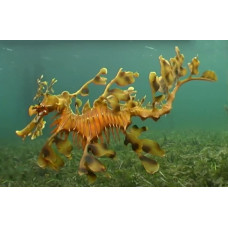Latin name
Phycodurus eques
Other names
Glauert's seadragon
Identification
Representatives of this species of fish are characterized by the fact that their entire body and head are covered with projections that imitate bundles of algae. Although these projections resemble fins, they do not participate in swimming, but serve as camouflage.
Features of fish fins
Leafy sea dragons move with the help of their pectoral and dorsal fins. These small fins sway very frequently (up to 10 times per second), allowing the fish to gently rock on the waves, creating the illusion of floating algae.
Fish colouring
The color varies: yellowish-green, yellow or orange-yellow. The pectoral and dorsal fins are almost completely transparent.
Distribution
They inhabit the waters of the Indian Ocean, which surrounds southern and southwestern Australia and northern Tasmania.
Habitat
A non-migratory marine species. Usually found on coral reefs, in shallow water at depths from 4 to 30 m (usually up to 20 m), in waters of moderate temperature.
Size
The body length of the Leafy Seadragon is up to 35 cm.
Behavior
They swim slowly, with a maximum speed of up to 150 m/h. Despite their low mobility, they have learned to defend themselves well against natural enemies. This is due to their greenish leaf-like growths that allow them to remain undetected.
Unlike seahorses, which use their tails to cling to seaweed in rough seas, ragfish are unable to do this, so they often die during storms when they are thrown ashore.
Food and feeding habits
It feeds on plankton, mysids and algae. It has no teeth and swallows its food whole (up to 3000 mysids a day).
Reproduction
Unlike seahorses, males of this species do not have a brood pouch. Like their close relatives, females lay up to 120 ruby red eggs, which are fertilized and attached to a special spot under the male's tail.
During the pregnancy, the pairs approach each other every morning and perform a kind of love dance with a change in skin color to lighter tones. Four to eight weeks pass and the birth of small fish (exact copies of adults) takes place.
Once born, the young are left to fend for themselves. Only 5 percent of the newborns become adult 2-year-olds that stay where they were born.
Fishing
Not interesting for fishing. Small numbers are caught for sale to aquariums.
Relationship with a person
The species is threatened with extinction due to industrial discharges, as well as becoming specimens in the collections of amateur divers fascinated by their appearance. Because of this threat, the species is protected by the Australian government.
| Classification | |
| Phylum | Chordata |
| Class | Actinopterygii |
| Squad | Syngnathiformes |
| Family | Syngnathidae |
| Genus | Phycodurus |
| Species | P. eques |
| Features | |
| Conservation status | Least Concern |
| Habitat | Pelagic |
| Life span, years | No information |
| Maximum body weight, kg | No information |
| Maximum length, cm | 35 |
| Sailing speed, m/s | 0,04 |
| Threat to people | Not edible |
| Way of eating | Planktonophage |
Leafy seadragon
Tags: leafy seadragon



